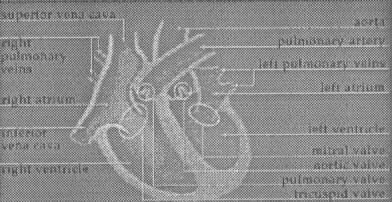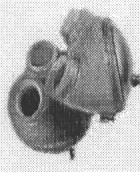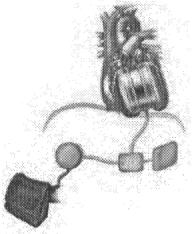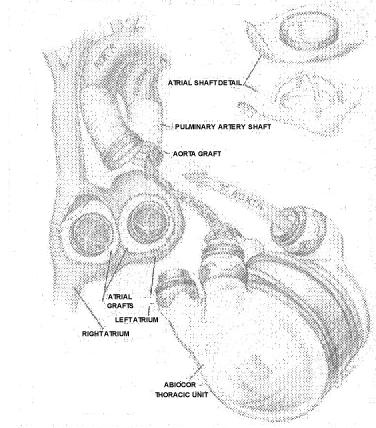|
Introduction to the Heart
The heart is one of the most important organs in the body. Without the heart, it is impossible to pump blood throughout the circulatory system. It is a muscular organ positioned just to the left of the breast bone (sternum). It does an amazing amount of work for being about the size of a clenched fist, and weighing only about 11 ounces (310 grams). The heart is basically a container for the four chambers inside it, which are filled with blood. Two of these four chambers are the atria, and the other two are the ventricles.
The atria make up the curved, top part of the heart. These two chambers receive blood from the lungs, or other parts of the body. The ventricles make up the bottom two ventricles, which meet together to form the pointed bottom of the heart. The bottom is curved towards the left side of the chest. The right ventricle pumps blood to the lungs so they can receive oxygen. The left ventricle pumps blood to the rest of the body, and is the strongest chamber. You can feel your heart beating on the left part of your chest because the left ventricle contracts with more force.
One atrium and one ventricle form the left side of the heart. The right side consists of the other two. The septum is a wall that separates the two sides of the heart. The mitral valve connects the left atrium and the left ventricle, and the tricuspid valve connects the right atrium with the right ventricle.
The top of the heart connects many important veins, called arteries, which carry out and feed the heart blood. The largest of these is the aorta, that branches off into several smaller arteries. The aorta carries blood out from the heart. It is very thick, about the size of a garden hose, whereas capillaries are not even the thickness of a strand of hair. The two largest veins that carry blood into the heart are the superior vena cava and the inferior vena cava. They are called this because they are the "veins of the heart". The superior vena cava is positioned on the top right part of the heart and the inferior vena cava is located below it.
Blood in your body flows continuously throughout the day and throughout a life span. The bloodstream occurs in these steps. First, oxygen-poor blood flows from throughout the body into the right atrium. From there, the blood continues into the right ventricle. Then, the blood is pumped from the right ventricle into the lungs. When the blood enters the lungs, it releases any unnecessary waste gases, and picks up the oxygen. The now nutrient-rich blood flows back into the heart and goes into the left atrium. From there the blood goes into the left ventricle. The left ventricle then pumps the nutrient rich blood throughout the body. This is a continuous cycle and does not stop from the time you are born until death.
To do all this work, the heart must be a very strong muscle. In one minute, the muscle contracts and relaxes an average 70-80 times. Nerves that are connected to the heart control the speed of contraction. When doing very physically active things, such as running, the nerves speed up the rate of the heart contracting, because it has to work harder in order for you to be able to run. When being physically inactive, such as sleeping and sitting down, the heart pumps more slowly.

The Need for Artificial Hearts
Artificial hearts could greatly benefit many people across the world. In the U.S. alone, about 700,000 patients die of heart failure every year. Artificial hearts would be able to benefit patients with congestive heart failure or coronary heart disease. Although it has declined over the years, heart failure is the leading cause of death in the United States. Congestive heart failure is common with older patients, who have hearts that have slowly deteriorated over the years. Coronary heart disease, common throughout all ages, is another problem that causes the heart not to function. The best option up to this date, has been heart transplants. However, in one year, there are only about 2,200 hearts available for transplants. There are about 7,000 potential donors every year, but only about 1/3 of them are used. This is because many of the donors are in tragic accidents, and their parents aren't ready to make a decision to give the heart up. Out of the thousands of people who have heart failure every year, they can either receive one of these hearts, if they are lucky, or just face their death. These 2,200 donors represent a huge gap in the need for hearts, and the availability of hearts. Artificial hearts are estimated to be able to keep 100.000 more Americans alive every year.
The JARVIK-7
When you understand how the heart works, you can attempt to "create" a heart. However, it is not so simple to just make one. The first attempt to make an artificial heart was the JARVIK7. This experiment was successful in some ways and unsuccessful in other ways. By many, it was considered to be too big of a step for it's time. The JARVIK7 was a fully implantable artificial heart, and that was a success. It proved that you could replace a human heart and keep someone alive on it, but the lives of the patients were greatly affected by it. For instance, patients had to be attached by wires and chords to an external pump or power source all the time. Also, there were high risks of blood clotting, infection, and strokes. There was a high risk of infection because the heart was attached to chords outside of the body. It is believed that some materials in the JARVIK-7 could increase the risk of strokes.

This experiment created a lot of disinterest in the idea of artificial heart. It was not accepted by the public or scientists. For almost 10 years, the artificial heart was not experimented with. An artificial heart was not being planned on, but there began to be other options for heart problems.
Ventricular Assist Devices
Ventricular Assist Devices (VAD) assist the pumping on either side of the heart. LVADs help pumping on the left side of the heart, and RVADs help the right side. Most people have failure on the left side of their hearts, because it is the side that pumps more forcefully. When the heart is not thoroughly pumping blood throughout the body, VADs help this happen without removing the heart. A cable connects the heart to a power supply worn outside the body. It is crucial that these devices work continuously for years, because if they stop working, there is about 5 seconds to fix it, or the patient dies. It is also necessary that these devices have air connections, in case of an emergency. A port can be attached to these air connections and you can manually pump the device to keep the blood flowing. These VADs are very important to patients with heart problems, but for many, they are not enough.
The Abiocor Implantable Artificial Heart
The Abiocorä implantable replacement heart is a huge step in the field of cardiology. It is a much more efficient heart, and could be much more useful than the JARVIK-7. The heart is about 3 pounds, and the size of a grapefruit. It is produced by the company Abiomedä, which has made many devices in the field of cardiology including one of the most commonly used ventricular assist devices. It is made completely of titanium and Angioflexä, a plastic made by Abiomedä that is very efficient, and is used in their VADs also. The pumps and valves consist of this plastic. Angioflex is very durable and can stand the contracting of 100,000 times a day (average of a natural heart). Also just like a natural heart, the Abiocor Artificial Heart has two blood pumping chambers. The right side pumps blood into the lungs, and the left side pumps the blood into many organs and throughout the rest of the body. The artificial heart is estimated to cost $70,000, which is a small price for extending life.

The artificial heart completely simulates the rythyms of a natural heart. Each of the two pumps are able to deliver about eight gallons of blood every minute. A major advantage of the Abiocor heart is that it has a lithium battery system that runs through electric transfer, instead of wires. An external power unit is worn on the outside of the body (on the shoulders) and transmits power into the unit. The rechargable internal battery can run by itself for an amount of time without the help of the external unit. Transcutaneus Energy Transmission (TET) makes recharging the internal battery possible. There are internal and external coils that transmit the power through the body without piercing the skin. This is a great advantage not only because it decreases the risk of infection, but the patient can move around freely, and get on with their lives, instead of being tethered to large energy sources, like with the JARVIK-7. The angioflex is a great plastic to be used because it is durable, and is believed to reduce the risk of blood clotting and stroke. It also reduces the chances of damage done to the blood cells.
The Abiocor system is very efficient in other ways too. The heart monitors the speed of pumping based on the needs of the patient. In this way, it is exactly like a natural heart. When the heart need to work harder and pump blood throughout the body faster, it does this. Also, this monitoring system alarms in case of irregularities in the body.
The abiocor artificial heart has all the parts that a natural heart has. It has artificial ventricles and their corresponding valves to connect to the arteries in the body. The unit has four openings to attach to your arteries. One attaches to the aorta and the other attaches to the pulmonary artery. The aorta and pulmonary artery
 have tubes attached to them to lengthen them that are called grafts. The other two openings attach to atrial grafts, that implanted onto the edges of the left and right atriums. have tubes attached to them to lengthen them that are called grafts. The other two openings attach to atrial grafts, that implanted onto the edges of the left and right atriums.
On July 2, 2001, Robert Tools received the first Abiocor implantable artificial heart. This was a successful surgery and a landmark in cardiology. Dr. Laman A. Gray Jr., M.D., and Dr. Robert D. Dowling, M.D. performed the surgery in Jewish Hospital in Louisville, Kentucky. Robert Tools died on November 29, 2001, due to abdominal bleeding and a multi-organ failure. This did not occur because of any type of malfunction or problems with his artificial heart. Since Robert Tools, there have been 4 more patients who received these Abiocor hearts. These surgeries have all been successful.
The Future of Artificial Hearts
With the Abiocor replacement heart, and possibly other artificial hearts, thousands of people across the globe could live longer lives. In the U.S. alone 100,000 people could benefit from artificial hearts. Over the years, artificial hearts will be more and more used. If approved, the Abiocor heart will go on the market in 2003. This a very promising field of study, and in the future, could very well reduce the number of deaths in the United States, and throughout the world.
| |